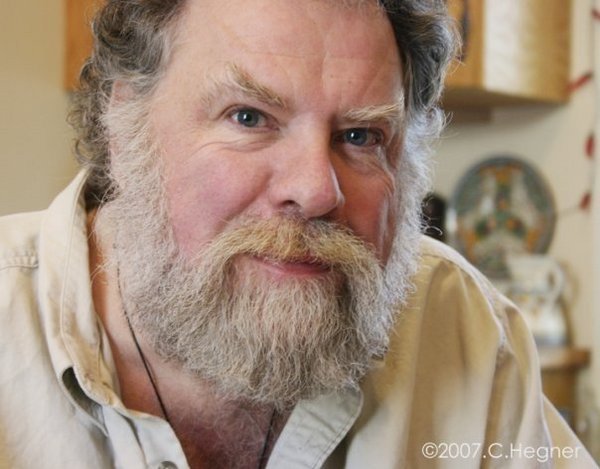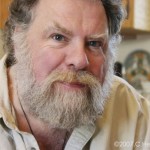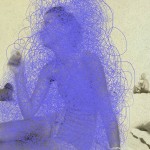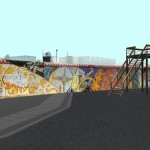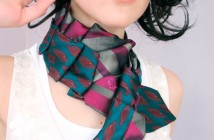10 YEARS OF CYBERARTS: A Q&A WITH GEORGE FIFIELD
Cyber artists from all over the world converge on Boston when the sixth Boston Cyberarts Festival opens on April 24. Since 1999, its director, George Fifield, has corralled more than 60 diverse cultural and educational institutions in the Boston area into presenting exhibitions, events, performances, discussions and experiments that explore where technology intersects the arts.
NB: Why did you start the Boston Cyberarts Festival?
GF: I became aware writing a column for Art New England on art and technology of a long history of artists working in new technologies in the Boston area. My initial idea was to celebrate this somehow, because nobody knew it was going on. So, we got a grant from the Mass Cultural Council, from a program that was the precursor to the John and Abigail Adams Fund, and put a call out to arts organizations and I thought we would be very successful if we had 20 groups collaborate with us. The first festival we had 60! And some of them brought in international artists. So apparently we had come up with a conversation everyone wanted to be a part of.
NB: How has Cyberarts evolved in 10 years?
GF: The two basic structures of the festival have remained intact. Firstly, the festival is a collaboration of arts and educational organizations – we don't do it all ourselves, we work with organizations like the Goethe-Institut, Photographic Resource Center,AXIOM Gallery, DeCordova Museum, and MIT Museum. And the second axiom is we are a festival in all media - music, dance, sculpture, film, video and digital literature - however technology is affecting an art form we are interested in exploring it. The biggest change has interestingly been in the types of technology that artists are using. Every festival someone is using a technology to make art that may not have even existed at the festival two years earlier.
NB: What's new at this year's festival?
GF: Virtual Reality is featured in several exhibits. We are having a whole examination of artist's working in Second Life, which has grown by leaps and bounds. The person who is sharing his space with us is a Lowell artist named Jeff Lipsky, who as Filthy Fluno (his Second Life persona) is very successful. There was a big article in the New York Times Magazine about him a few weekends ago. He has a real art gallery, CounterpART, in Lowell, which will have a celebration at the same time that we have our art opening in Second Life. Jeff has a Second Life Island called "Artropolis" which he is sharing with us – and we will be presenting a number of artists there.
At the Goethe-Institut, Tamiko Thiel and Teresa Reuter are creating an interactive virtual reality of Berlin when the wall was still up – you can wander around and see what it's like to live in a city that is bisected politically, physically and spiritually.
And, the Cambridge Arts Council Gallery is hosting "Children of Arcadia," in which you can enter into a Baroque painting that is connected in real life to the stock market and to other indicators of the health, or lack of health, of the United States. If things are going well, the skies are blue, and if things are going poorly then the skies are dark and raining and the buildings start to collapse. We'll have a whole discussion on Virtual Reality at Boston University on Monday, April 27.
NB: Any works you're directly involved with?
GF: I am very excited to be working on "The Loops Project." A little background - in 2001, the MIT media lab did a show called "ID/entity." They paired up artists with media lab people. Two artists - Paul Kaiser and Shelly Eshkar were paired with Marc Downie, and they are still working together today. They did a project called "Loops" in which they motion-captured choreographer/dancer Merce Cunningham doing a performance of "Loops" – a one-person dance he created and performed. They took the motion-capture data set, and they ran it through software they devised – making it this beautiful, abstract, flat-screened, flowing, glowing experience. But when you are watching it you can discern human intelligence behind it. Last February, the Cunningham Foundation, and OpenEnded Group (the three artists) put the choreography, the motion-caption data set, the software they used to manipulate the data, and the soundtrack all on-line as an open resource. We applied to the LEF Foundation and got a grant, and we've asked four artists - Brian Knep, Golan Levin, Casey Reas, and the performance group Sosolimited to re-purpose the material in completely different ways. And after the 5:30-7:30 opening at the MIT Museum on Friday, April 24, there will be a dance performance at 8pm. If you go to the Cyberarts website there is a big "Loops" button, and you can find everything out about it.
NB: How has technology affected the arts or the arts effected technology?
GF: In fact most of what the festival has explored has been how artists who are working in traditional art forms – for example, printmakers, sculptors, and dancers – are integrating technology into their work. It's fun to watch. Almost as soon as a new technology comes along, there are artists using it as a medium of expression. A few years ago, all of a sudden there was all this locater media art happening. As soon as affordable GPS devices appeared on the market, artists were using them to make art. And as cheaper, less expensive Virtual Reality technology became available artists started using it to make art as opposed to the expensive tech of the 90's. The changes are lightning fast.
NB: How do you decide what to include in the festival?
GF: In many ways we don't. It's a collaboration of approximately 60 organizations. They come to me with the programs they want to do. At that point all we can say is "Yes, we think this should be included." And, we almost never say no. The organizations have a very good sense of what the festival is about. Somebody like the Photographic Resource Center's Leslie Brown has done these great exhibitions where she really gets under the ideas of what technology is when you use the phrase in terms of art. Their current show, "SYNTAX," is about artists who are mainly photographers, but they are approaching the data that's actually in the photos in interesting ways. AXIOM Gallery, which is Boston's new media gallery, did their first show during the 2005 festival. They've done major exhibitions for the festival ever since. "Parse: Visualizing Data that Makes Us Human," the exhibit up now, is about artists who are envisioning the databases in their art.
NB: Where's the best place to get information about the festival?
GF: Cyberarts Central is at 1330 Boylston Street in the Fenway. You'll be able to talk to volunteers, pick up a festival t-shirt and find out where and when exhibits, concerts, openings, and events are taking place. There are also going to be three exhibits in the space. The first exhibit is called "Continuum" – and contains two parts. Part One is work by graduate and undergraduate digital media students from schools all around Boston - RISD, Mass Art, the Museum School and Emerson. Part Two is animations from the collection of Ann and Michael Spalter – these are the earliest animations done by computers at Bell Labs back in the 60's by people like Lillian Schwartz and Mike Noel. So, we're going to have the oldest computer art and the newest computer art in the same exhibit. And, across the street at a space called Fourth Wall (which is an old Volvo gas station) there will be an exhibit of classic video games, old Atari Games, and old arcade games being organized by a couple of people Including Nick Montfort, who teaches at MIT. And, of course, you can access an entire schedule of events on our website.
- George Fifield
- Matthew Swarts, Untitled, Pigmented inkjet on aluminum panel, 2006. On view in the exhibition “Syntax” at the Photographic Resource Center.
- Tamiko Thiel & Teresa Reuter , Berlin Wall: Wall Art 1980s, 2008. On view at the Goethe-Institut Boston.
A CONVERSATION WITH GEORGE FIFIELD by MEG ROTZEL in issue #21
"The Boston Cyberarts Festival" occurs throughout the Boston area April 24 - May 10, 2009.
Fifield image via Facebook.
All other images courtesy of Boston Cyberarts.

